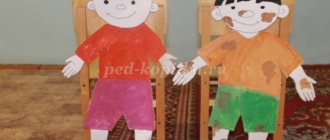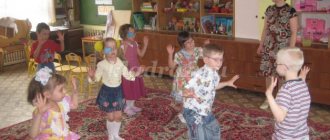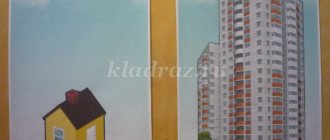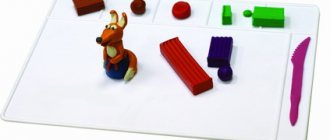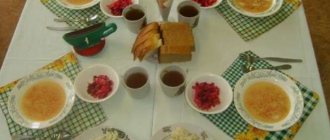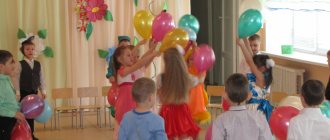Basic principles of organizing the daily routine
Definition 1
Daily routine is a measured order of actions planned for the day.
While the child is in kindergarten, his life activities correspond to a regulated routine. The alternation of educational activities and outdoor games, rest and active wakefulness helps to avoid nervous fatigue in children.
Depending on their age, children are engaged in mastering certain self-service skills and learning to communicate culturally. It is important that in kindergarten the child not only develops, but also satisfies his need for active movements, nutrition, timely rest, etc.
Planning of routine moments in the middle group is based on studies of the physiology of children. Taking into account the age characteristics of the pupils. The basis of the regime are the following principles:
Are you an expert in this subject area? We invite you to become the author of the Directory Working Conditions
- rhythmicity - changing types of activities in accordance with internal cycles characteristic of children 4-5 years old;
- cyclicality – a constant schedule forms a habit and relieves nervous tension;
- alternation of rest and active pastime - throughout the day, outdoor games replace quiet activities, educational activities are replaced by artistic activities, and wakefulness is replaced by sleep;
- flexibility - when the child is tired, he should be able to retire. If he wakes up too early, he engages in quiet games with books and toys;
- gradualism - preschoolers should not be rushed, they should be given the opportunity to independently complete the work they have started;
- individual approach – some children may need additional help and special attention. The teacher must gradually include them in the general rhythm.
Summary of the organization and conduct of regime processes of the first half of the day in the preparatory group of the preschool educational institution
I tell the guys:The crow delivered an envelope to me. I found riddles in this message. If you find the answer, you will make friends.
- Let's solve them, maybe then we will find out who this letter is from.
Not a lamb or a cat Wears a fur coat all year round. A gray fur coat is for summer, and a different color for winter.
Children: Hare.
Correct, but how did you guess? Children: A hare has a gray coat in summer and white in winter. He specially camouflages himself so that predators, or rather his enemies, do not see him. What are the hare's enemies? Children: Fox, wolf and man. Guess the second riddle.
The owner of the forest wakes up in the spring, and in winter, to the howl of a blizzard, he sleeps in a snowy hut.
Children: Bear. Why did you decide so? Children: Bears sleep in dens in winter and wake up in spring. Next riddle.
Behind the trees and bushes A flame flashed quickly Flashed, ran - There was no smoke, no fire
Children: Fox. “The fox is red, so it will run as if something is burning.”
Well done, we have already guessed almost everything. There are only two riddles left.
Toothy, grayish, prowling the field, looking for calves, looking for sheep.
Children: Wolf The last riddle.
Has a nest in a tree, Jumps and flies along the branches, Not a bird.
Children: Squirrel. She has a nest in a hollow. And she jumps very well, as if she were flying. So who sent this letter? Children: Animals. Guys, who guessed where they are inviting us? Children: Into the forest!
You and I will go for a walk in the forest to visit the animals. But this forest is not just a forest, this forest is a wonderland. Now, stand behind... the back of your head, and go for a walk.
(Children line up in a column one at a time and walk one after another.)
Top, top, one, two, three, Don't look at your feet, Don't lower your head, Let's walk happily.
Reading with the children:
Hello forest! A dense forest, full of fairy tales and miracles! Who is languishing in your wilderness? What kind of animal? What bird? Open everything, don’t hide it: You see we are ours.
I ask:
That's who's up ahead. They jump lightly, Land quietly, Jump-jump, jump-jump.
Children: These are bouncing bunnies. Calling the hares: Bunnies, come here.
Three rabbits (children wearing masks) come to the board.
1st hare: Hello guys, we are very glad to see you. I am a hare, and these are my bunnies. I'm telling you: Hares live in small groups. They lie all day, hidden in some depression or hole, and at night they go out in search of food. 1st hare: When we are safe, we walk in the sunshine. 1st and 2nd hares: We only sleep during the day. Let me explain: The hare walks awkwardly, this is due to the fact that the long hind legs make movement difficult.
Hares show.
1st hare: But when we run, our movements are fast and dexterous. 2nd hare: If necessary, we can even swim across the river. 3rd hare: Don't brag! I’m telling you: Hares are always on guard, always ready to run away. 3rd hare: Do you know how many enemies we have? Children: Wolves, foxes, humans. 3rd hare: Not only. But also eagle owls, crows, lynxes, magpies. 2nd hare: But we run well, I especially like to run uphill, and head over heels downhill. Let me explain: Yes, thanks to their hind legs, hares run uphill perfectly. On level ground they easily jump over streams and holes. 2nd hare: And sometimes we hares take a running jump over walls and fences 2-3 meters high. 3rd hare: In winter we run well on ice because we have hard hair on our paws that prevents slipping. And we also know how to confuse our tracks. 1st hare: First we will run past our house for some distance, then we will jump back and to the side. You’ll do this seven times, and then no one will follow your steps and find your house. I ask the children: Guys, what protection do you think hares have? Children: The hares are running away. I add: They also change their fur. 2nd hare: We are molting! Let's disguise ourselves! I say: But why are you suggesting? Ah ah ah! Why do bunnies camouflage themselves? D. So that they will not be noticed. For example, in winter the snow is white - and hares have white fur coats. I ask: Do you know why hares received the nickname “slanty”? Children: Because their eyes are slanted. 1st hare: Nothing of the kind. Our eyes are big, beautiful, and do not squint. But people usually see us running away, and since our neck is inactive, we cannot look back, so we squint our eyes to see where the pursuer is. 2nd hare: Mama hare, tell us better about us. 1st hare: Okay! The babies of us hares are born well developed, with open eyes and covered with fur. Bunnies can clean themselves. They feed on milk. 3rd hare: Mom’s milk is very fatty and tasty. Very nutritious. 2nd hare: Yes, it lasts for several days. 1st hare: I have bunnies three times a year. I add: The first time was in March or April. 3rd hare: Nastovichki. Guys, why are they called that? D. Because the crust is still lying. 3rd hare: What is crust? Children: Snow sometimes becomes covered with a hard crust. This crust is the crust. I say: Correct. The second time the hares are born is in June. When the rye heads, the buckwheat blooms. What do you think they are called? D. Spikelets, spikelets, buckwheat. 2nd hare: Oh, how funny! Well, you’ve almost guessed it – spikelets or buckwheat. I inform you: The third time rabbits are born is in August. 1st hare: Falling leaves. Children: Because the leaves are falling. 1st hare: That's right. See how much you've learned. I want to share a secret. People think I'm a bad mom. My milk is very nutritious. After drinking it, the bunnies do not want to eat for several days. And then I or another hare will come running and feed them. Do you know why I have to do this? We have sweat glands on our paws that leave a scent that predators can easily use to find us. The little bunnies have no smell yet, so you have to leave them alone. But they will be safe. 2nd hare: Oh, someone is coming here, let’s run. Hares: Goodbye! I tell the children: It’s good that we met the bunnies. It’s just a pity that they didn’t have time to tell us about brown hares and white hare. I'll tell you about them. The hare is the largest of the hares living with us. It is brownish-yellow in color, with gray speckles. In winter and summer it is the same color. It still brightens a little towards winter. The white hare is smaller than the trotting hare. In summer it is dark reddish brown and in winter it is white.
I show illustrations or photographs of hares on the board.
You see how much we have learned. Be sure to tell us about the secret forest inhabitants of your home today.
Fizminutka
Children stand near the table and do exercises.
Bunny, come out! Gray, come out! That's it, come out that way! Bunny, turn around! Gray, turn around! Bunny, stamp your foot! Gray, stamp your foot! Like this, stomp your foot like this! Bunny, dance! Bunny, bow!
After completing these exercises, the children sit down.
I tell the children: How quickly time has flown by. Did you find out anything interesting? Do you remember? Let's check it now.
I ask questions:
- The largest of the hares in our forests.
- What name did the hares born in June receive, when the rye is earing and the buckwheat is blooming?
- In winter, hares are white, why?
- Save from enemies...
Answers:
- Hare.
- Kolosovichok.
- Disguise.
- Legs.
If we are just as attentive to other animals, we will learn a lot of new things. Who else should we meet in the forest? Children: With a wolf, a fox, a squirrel and a bear. Right. But today it is too late, and we are returning to the group. We will continue our journey into the forest next time.
Top-tomp, one, two, three, Don’t look at your feet, Don’t lower your head, Let’s walk and walk merrily.
